Hours later,the vision compiled by Al-Aksha Bhuiyan was edited and distributed online via a slick campaign platform,Stand For Palestine.
The group emerged shortly after the Hamas terrorist attack on October 7 that left more than 1200 Israelis dead and dozens taken hostage,and as Israel’s brutal and bloody response was under way.
In a break from filming,as students in graduation garb flanked by their parents passed the university quadrangle where the protesters had also set up camp,Bhuiyan explained he was Stand For Palestine’s multimedia co-ordinator but politely declined an interview. He’s not so reserved online.
In social media posts,Bhuiyan has written that Muslims will “continue resisting until Israel is completely wiped off the map,from the river to the sea”. He supports “armed resistance against Zionist barbarism”.
Police threatening to shut down student encampments are acting “in obedience to the corrupt state”,while Muslim groups that deal with Australian politicians are sell-outs.
It is not suggested Bhuiyan’s extreme views are endorsed more broadly by a protest movement that has mobilised to raise justified concerns about Israel’s bloody response to the Hamas attack,which has cost more than 37,000 Palestinian lives,according to Gaza health authorities.
But Bhuiyan’s activities on campus and online shed rare light on a hidden and fringe pocket of the pro-Palestine movement:that involving the Australian operation of a radical international Islamist group,Hizb ut-Tahrir. In January,the group was banned in Britain as a terrorist organisation after it expressed support for Hamas,itself a proscribed terrorist outfit.
While there is no suggestion Hizb ut-Tahrir has any official role in the regular weekend rallies that have drawn thousands to the streets in Sydney and Melbourne,the group’s Australian chapter is highly active and seeking to influence the broader protest movement.
Bhuiyan is a cog in Hizb ut-Tahrir’s sophisticated campaign to seize on legitimate grievances about the Gaza conflict to muster support for the controversial group’s goal to destroy Israel as part of the creation of a caliphate ruled by Islamic law and stretching across majority-Muslim nations.

As it seeks to recruit and radicalise,Hizb ut-Tahrir is using front groups to infiltrate the university encampment and pro-Palestine movements.
The most prominent is Stand For Palestine,a pop-up group that operates across multiple online platforms and works in coalition with several Muslim groups,including at least one that was unaware of Hizb ut-Tahrir’s role in pulling the strings.
Where Hizb ut-Tahrir is regarded warily by many in the Muslim and broader community due to its hardline views,limiting its membership,Stand For Palestine has no obvious extremist baggage.
In a few months,it has gained 33,000 followers across social media,helped organise protests in Sydney and Melbourne and encouraged demonstrations and the defacing of the prime minister’s office.
A deep dive of the online accounts of its backers also reveals that Hizb ut-Tahrir Australia has stepped up its presence in mosques and youth groups.
Despite the group’s long history of antisemitism and hate speech,and its January banning in Britain,it has attracted almost no recent public scrutiny in Australia,save for the occasional removal of content deemed offensive by the tech giants.
Two weeks after October 7,Bhuiyan,who regularly shares and promotes Hizb ut-Tahrir events and media releases on social media,decried Facebook’s decision to shut down one of the group’s accounts.
“The enemies know very well the voices they need to suppress,” he wrote.
As for Hizb ut-Tahrir’s banning as a terror outfit in Britain,Bhuiyan says it is “a wake-up call for Muslims to finally come out of the illusion of their cozy relationship with the West and embrace the struggle of … Islam v kufr[non-belief]” .
In mid-January,British Home Secretary James Cleverly announced Hizb ut-Tahrir would be declared a terrorist organisation to “ensure that anyone who belongs to and invites support for them will face consequences”.
He claimed the group was an “antisemitic organisation that actively promotes and encourages terrorism,including praising and celebrating the appalling 7 October attacks”.
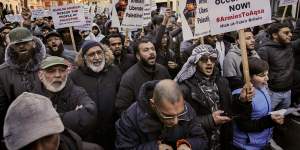
A Hizb ut-Tahrir protest in London in November.Alamy Stock Photo
Hizb ut-Tahrir’s UK chapter had earlier published a media release describing Hamas’ attackers as “heroes” and urging the Muslim world to be inspired by the stunning impact of the “resistance group”. British officials also cited Hizb ut-Tahrir’s involvement in a pro-Palestine rally in London.
The ban was supported by the Labour opposition but sparked intense debate in Britain about whether it was justified or a politically charged stunt by a Conservative government lagging in the polls. Some critics highlighted Hizb ut-Tahrir’s historical repudiation of violence in its quest for a caliphate.
Founded in 1953 in the Middle East,Hizb ut-Tahrir has publicly differentiated itself from violent outfits such as Islamic State. IS,in turn,has snubbed Hizb ut-Tahrir as too soft and scholarly.
The British debate about the effectiveness of the ban mirrored discussion in Australia in 2015,when former prime minister Tony Abbott sought but failed to have the group proscribed,arguing the federal government had to “tackle the people and the organisations that justify terrorism and act as its recruiting agents – such as Hizb ut-Tahrir”. Australia and the UK have differing legal tests for proscription.
Hizb ut-Tahrir was also criticised during the Lindt Cafe siege inquiry,which found that gunman Man Haron Monis had attended several of the group’s events before taking hostages in the Sydney cafe in December 2014. The inquiry’s final report cited terrorism experts who labelled Hizb ut-Tahrir an “Islamic extremist group” that could act as a gateway to explicitly violent groups.
Deakin University extremism expert Josh Roose says the group is unquestionably extremist and has seized on the violence in Gaza as “their time to shine”.
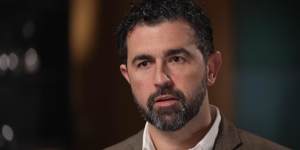
Deakin University extremism expert Josh Roose says Hizb ut-Tahrir has used the Gaza conflict to boost its activism.60 Minutes
“They might not be necessarily crossing that line into advocating terrorism,but there is inherent violence in what they’re doing,” he says.
This masthead is not suggesting Hizb ut-Tahrir supporters are terrorists or that all its members condone terrorism.
Roose is a sceptic of the British decision to ban Hizb ut-Tahrir as a terror group,but he insists the group should be scrutinised in Australia,just as he supports scrutiny of neo-Nazi cells.
He also believes there is a pressing and “clear case” to strength Australia’s hate speech legislation to combat Hizb ut-Tahrir’s “violent rhetoric” and antisemitism.
Yet,it has avoided publicity in Australia,even as the group’s local adherents engage in activities almost identical to its British counterparts.
Like so much modern activism,it began with a series of online posts. Hours after fighters flooded into Israel,Hizb ut-Tahrir’s international headquarters posted a historical video of the founder of the group’s Australian arm,Ismail Alwahwah,who died last year after a busy life that included a stint in a Jordanian jail and frequent scrutiny in Australia for virulently antisemitic preaching.
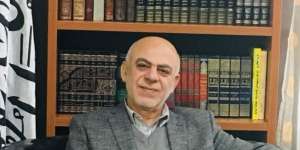
Ismail Alwahwah,traditionally known as Abu Anas (father of Anas),founded Hizb ut-Tahrir’s Australian branch.Hibz ut-Tahrir
In the video,Alwahwah is portrayed as a visionary who foresaw the calamity befalling what he called the “evil illegal occupier” and who had vowed that Israel’s inevitable humiliation would inspire Muslims to “celebrate”,“laugh” and “smile”.
Shortly after that,Ismail’s Sydney-based son,Anas Alwahwah,posted his own video. Under a caption that read,“May God have mercy on my father and grant quick victory”,it showed a man on a motorcycle wearing a black balaclava and military battle vest favoured by the Hamas fighters who had just streamed over the Gaza border.
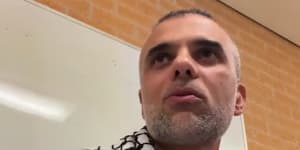
Anas Alwahwah is the son of Hizb ut-Tahrir Australia’s late founder,Ismail Alwahwah,and is a senior activist for the group.Supplied
Anas Alwahwah is a senior Hizb ut-Tahrir activist in his own right. While generating none of the public profile of his father,he was named on the paperwork when Hizb ut-Tahrir applied to the Office of Fair Trading NSW to be registered as an incorporated association in 2013. He has become an active organiser and participant in the group’s events over the past 12 months.
Another of Ismail’s relatives,Amer Alwahwah,who is also closely aligned with Hizb ut-Tahrir,gave a speech describing the events of October 7 as an inspirational moment that “set the spark” but that required “further friction from our end”.

“This is why the flood of al-Aqsa was initiated – because what does a flood do? It runs,it moves,it drags and it drowns. And all it took was one flood to drown … many traitors.”
On October 8,Hizb ut-Tahrir called an “emergency gathering for Palestine” at Lakemba in Sydney’s south-west.
A video of the event shows Anas Alwahwah passing through the screen as radical Islamist Ibrahim Dadoun,another regular at previous Hizb ut-Tahrir events,embraced Ismail Alwahwah’s video prophecy.
“I’m smiling and I’m happy,” Dadoun said,as news bulletins around the world were still broadcasting images of terrified Israeli hostages,including civilians who had attended a dance party,being bundled into Hamas trucks.
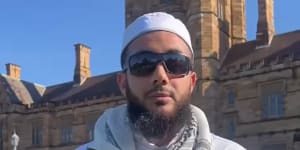
Following Hamas’ attack on southern Israel on October 7,Sheikh Ibrahim Dadoun said he was “elated” and described the deadly offensive as a “day of courage”.Instagram
“I’m elated. It’s a day of courage,it’s a day of pride,it’s a day of victory. This is the day we’ve been waiting for.”
While Dadoun’s comments,which he later denied,condoned the killing of civilians,were reported in Australian news bulletins and condemned by Prime Minister Anthony Albanese,no one drew the link to Hizb ut-Tahrir.
The group’s Australian chapter similarly avoided scrutiny after it republished a call to arms issued by Hizb ut-Tahrir’s Palestine branch aimed at convincing armies in Muslim nations to join Hamas’ fight against Israel.
“The Mujahideen’s Attack on the Jewish Entity Mandates the Ummah and its Armies to Rush to Support Them”,the press release republished by Hizb ut-Tahrir Australia stated.
It also described how Hamas’ capturing of Israeli “soldiers and the hoards[sic] of their settlers” arouses “feelings of pride and dignity”. The release lauded the “killing of Jewish soldiers and settlers” and “the courage of the mujahideen”.
A separate press release issued by Hizb ut-Tahrir’s Australian office on October 8 endorsed the “surprise dawn raid” of October 7 undertaken by “the brave Muslims of Palestine”.
“There is no solution to occupation except to persist with resistance efforts,” the release said,attacking Albanese while praising the “courage of individuals” involved in the terror attack and calling on neighbouring Muslim armies to join the fight against Israel.
In the days after October 7,Hizb ut-Tahrir’s Australian activists would issue this call to arms repeatedly.
On December 2,during a fiery speech,Anas Alwahwah claimed Hizb ut-Tahrir was actively lobbying Muslim soldiers “to break their chain of command” and enter the Gaza war to realise the dream of a caliphate.
The preacher's comments at a protest on October 8,2023 were condemned by the prime minister.
“The sharia obligation is for people who have the capability to rise and wage jihad … they have an obligation to wage jihad today,right now,” Anas preached.
“Hizb ut-Tahrir has a wing … a secret wing that’s[sic] job is only to contact armies … to convince them to be on the side of the ummah[global Islamic community].”
“Hizb ut-Tahrir has statesmen ready to assume[caliphate] rule from day one. So when you present that to the armies,it shows that this is serious work. We are not playing games here.”
Anas Alwahwah also celebrated the new year in Australia with a social post. It pictured Hamas rockets being fired towards Israel,comparing them to New Year’s Eve fireworks that “reached many cities inside ‘Israel’ including Tel Aviv”.
His post also celebrated that,despite widespread bombardment of Gaza,Hamas’ tunnel network was intact:“One thing is for sure;the underground city has not been harmed!”
Roose says the post is one of several that reflect the way Hizb ut-Tahrir has sought to wrap its long-standing vision for a caliphate around the Gaza conflict,hoping the latter would propel the former.
“He’s celebrating the launch of missiles on Israel … It’s clear as day,” Roose says. “It’s their attempt to go out there and build,and to talk about the legitimacy of their struggle and their movement,and to attempt to recruit.”
Anas’ talking points mirror Hizb ut-Tahrir Australia’s press releases,both depicting the war in Gaza as a fight between “Islam or the Kuffar[non-believers]”.
In early January,Hizb ut-Tahrir Australia released a branded video showing footage of Hamas terrorists on October 7 firing RPGs,shooting automatic rifles and paragliding into Israel.
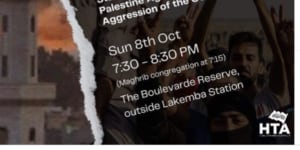
Flier promoting Hizb ut-Tahrir’s protest in Lakemba the day after the October 7 attacks.Instagram
The video was accompanied by the words:“The Al-Aqsa Flood has made clear the reality of the clash. It is a clash of civilisations,between the Muslims and their enemies. It is a clash between kufr[non-belief] and iman[faith]. It is enmity against the Islamic Ummah.”
When it was Amer Alwahwah’s turn to inspire,he published a video on social media with a caption describing the October 7 attacks as “the flood of Aqsa battle” that would ensure the “liberation of Palestine”. He said it was “written today by the blood of martyrs” and advocated for the installation of Jerusalem as the future capital of the caliphate.
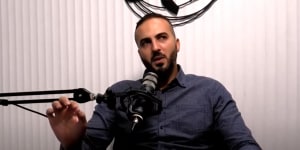
Hizb ut-Tahrir activist Amer Alwahwah.Supplied
In another post,he quoted the spokesperson of the military wing of Hamas,the Izz al-Din al-Qassam Brigades,Abu Ubaida:“This battle will change the face of the region.
“God willing,there will be a region without a Zionist entity or Zionist Arab regimes.”
But Hizb ut-Tahrir in Australia also had a less radical face. It was on display at the Sydney University quadrangle at a series of events in May. Its genesis was many months earlier.
The birth of a front group
Before Stand For Palestine,there was Stand4Uyghurs.
In 2022,Al-Aksha Bhuiyan posted about the latter group as part of a new campaign raising awareness “about the injustices facing the Uyghur Muslims of east Turkistan” at the hands of the Chinese government.
The campaign platform appears to be in line with what extremism scholar Richard McNeil-Wilson – who is a – has described as the group’s adept use of “front groups to mask their operations”.
One of the two authors/administrators for the group’s website was “Moey Alwahwah”,another of the relatives of Hizb ut-Tahrir Australia’s founder.
Speakers at its launch included Sheikh Ibrahim Dadoun and another Hizb ut-Tahrir activist,who noted the “important contribution of Hizb ut-Tahrir in lending help and an important hand with the logistics and the volunteers”.
After October 7,multiple Stand4Uyghurs social media platforms were quickly patched over with a new name:Stand For Palestine.
If Stand4Uyghurs was busy,Stand For Palestine was prolific.
One of Stand For Palestine’s first messages was circulated online by former senior Australian Hizb ut-Tahrir activist Uthman Badar (he resigned from the group in 2019 but remains closely affiliated) on October 13.
Titled “Friday Khutbah[sermon] Talking Points”,it praised the Hamas attack as a justified response to years of Israeli oppression,describing October 7 as an act of “audacious resistance” that had left the world’s Muslims “happy”.
Badar also mentioned the Stand For Palestine design was to “be used across multiple initiatives in a campaign to support Palestine”.
Soon,Anas Alwahwah’s name would appear as one of the administrators of the Stand4Palestine WhatsApp group,along with his relatives Amer and Mohammed.
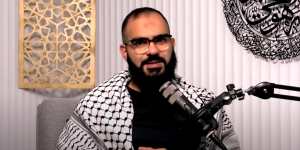
Mohammed Alwahwah,a relative of Hizb ut-Tahrir Australia founder Ismail Alwahwah. He is the administrator of the Stand4Palestine WhatsApp group.Supplied
Metadata reveals the Stand4Palestine Telegram group is administered by a Tunisian Hizb ut-Tahrir activist.
On November 6,the new group encouraged a boycott of Jewish-owned businesses Spotlight and Anaconda,with a follow-up on November 8 featuring a change.org petition.
On November 21,it pressed for a boycott of Kogan,calling it a “propagator of Zionism and its ideology”.
On November 10,it joined other pro-Palestine groups in encouraging its supporters to protest in Caulfield for the Burgertory restaurant “subjected to arson attack” with a call to “display our disdain and strength of our community”. The protest involved that required a synagogue to be evacuated.
When the Sydney University encampment was created,Stand For Palestine activists arrived with tents and cameras. Among them was a familiar cast of longtime Hizb ut-Tahrir supporters.
On May 23,the group promoted a talk at the university quadrangle by Mohammad Alwahwah,the second he had delivered on campus. Two days later,Amer Alwahwah hosted an on-campus talk with a Palestinian activist. Amer and the same activist gave the same talk under the Hizb ut-Tahrir banner a week after that.
Hizb ut-Tahrir backer Dadoun also appeared on the university campus as part of events organised by Stand For Palestine,with Dadoun leading a march while chanting “from the river to the sea,Palestine will be free”.
Dadoun explained to the encampment that the chant needed to be repeated often and loudly because “this is what makes the Zionists tremble in the knees”.
When this masthead approached Dadoun on campus,he refused to answer questions.
In May,Al-Aksha Bhuiyan introduced himself to this masthead on campus as the multimedia organiser for Stand For Palestine.
When called by this masthead in early June,Bhuiyan described himself as a Hizb-ut Tahrir supporter but said the Alwahwahs were its leaders. He confirmed Hizb-ut Tahrir was involved in both Stand4Uyghurs and Stand For Palestine,but said the group was working as part of a broader coalition of activists.
Asked about his own online comments,such as his seeming support for “armed resistance against Zionist barbarism”,the quietly spoken and polite Bhuiyan declined to offer an explanation.
Like the Alwahwahs,Bhuiyan’s online advocacy makes it clear he believes Islam endorses “the removal” of Israel,with the Jewish state subsumed into a wider Islamic caliphate.
He recently urged his social media followers to attend a “Hizb ut-Tahrir Australia” meeting that “shouldn’t be missed” because it would explain why the two-state solution endorsed by the UN and Australia should be opposed.
Bhuiyan also believes Hizb ut-Tahrir is being unjustly targeted.
“We have seen pervasive attempts to ban the advocacy for the khilafah[caliphate] worldwide,now made clear in the UK through the example of proscribing HT – the only prominent group with a focus on advocating for the re-establishment of the khilafah.”
In a statement,organisers of the Sydney University protest said the camp was made up of a variety of groups and organisations including socialists,queer activists and Muslim students.
“We’re a broad and diverse community here to simply demand our university cut ties with genocide and Israel,” the statement said.
On Friday,the university.
If the proscription debate does flare up in Australia,it is likely it will only entrench the Islamist group’s narrative that the west offers Muslims nothing except persecution.
At a Hizb ut-Tahrir Australia event in early May,Anas Alwahwah urged Australians to recognise the Gaza conflict as “a clash of civilisations ... between the West and Islam” and “hold on to this fact with an iron fist”.
“Everything that came from the West,from systems,from monies,from concepts,from nation states,from rulers,from borders,from identities,has been utter evil for us and a source of humiliation.”
For more,watch60 Minutes on Sunday night at 8.05pm.